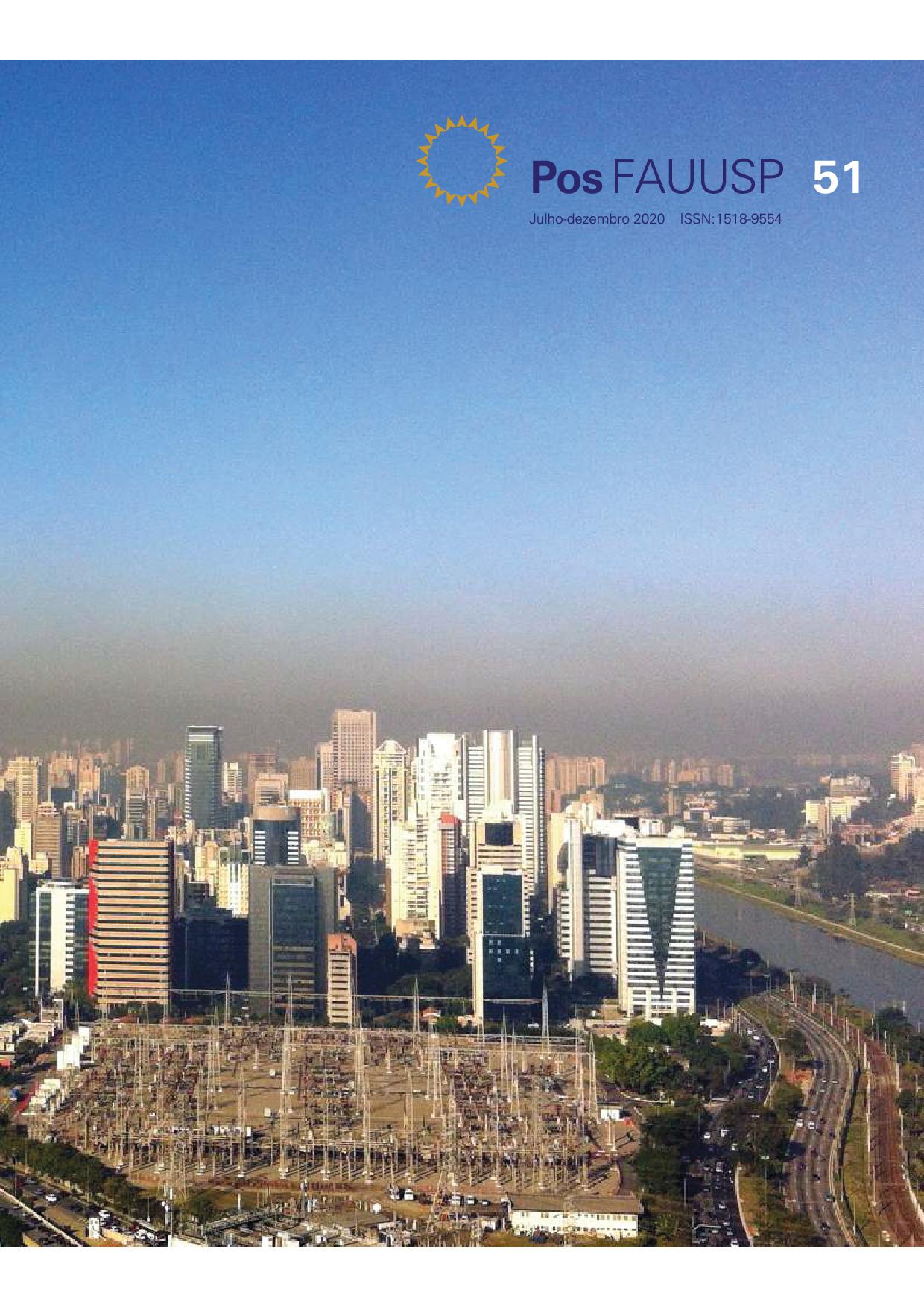Impacts of City Morphology on the Microclimatic Conditions of Consolidated Urban Areas in São Paulo during Hot Days
DOI:
https://doi.org/10.11606/issn.2317-2762.posfau.2020.168232Keywords:
Thermal conditions, Open urban space, Urban microclimate, Urban morphologyAbstract
The goal of this project is the investigation of the potential impacts that different urban morphological compositions of settlements in consolidated urban areas can cause on local microclimate conditions during hot days as perceived on the pedestrian scale. The evaluation is based on the survey of empirical data, established on computer simulations of the thermal conditions of open urban environments of examples of different districts of São Paulo, using the ENVI-met software, calibrated from empirical measurements of microclimate variables in existing environments of the city. The results of the evaluations allow the verification of microclimate variables found in each location in comparison with the characteristics of each urban occupation of the different models, which makes it possible to understand how the different urban morphologies respond to the same climatic conditions. Therefore, this project verifies some of the main impacts that the distributions, shapes, geometries and interactions of buildings can have on the microclimate of our cities during hot days, taking as an example representative neighborhoods of São Paulo.
Downloads
References
ABNT. NBR 15.220-2 - Desempenho térmico de edificações Parte 2 - Métodos de cálculo da transmitância térmica, da capacidade térmica, do atraso térmico e do fator solar de elementos e componentes de edificações. Rio de Janeiro: ABNT, 2013.
AMORIM, F. P.; TANGARI, V. Estudo Tipológico sobre a Forma Urbana - Conceitos e Aplicações. Paisagem Ambiente - Ensaios, São Paulo, n. 22, 2006. 61-73.
ASSIS, E. S. Abordagem do Clima Urbano e Aplicações no Planejamento - Reflexões sobre uma trajetória. Anais do VIII Encontro Nacional e IV Encontro Latinoamericano de Conforto no Ambiente Construído (ENCAC/ELACAC). Maceió: ANTAC - Associação Nacional de Tecnologia no Ambiente Construído. 2005.
GARTLAND, L. Ilhas de Calor - Como mitigar zonas de calor em áreas urbanas. Tradução de Silvia Helena Gonçalves. São Paulo: Oficina de Textos, 2010. ISBN ISBN 978-85-86238-99-4.
GUSSON, C. D. S. Efeito da densidade construída sobre o microclima urbano - construção de diferentes cenários possíveis e seus efeitos no microclima para a cidade de São Paulo, SP. São Paulo: Dissertação de Mestrado. Faculdade de Arquitetura e Urbanismo da Universidade de São Paulo (FAU USP), 2014.
IAG/USP. Boletim Climatológico Anual da Estação Meteorológica do IAG/USP - 2017. São Paulo: Seção Técnica de Serviços Meteorológicos do Instituto de Astronomia, Geofísica e Ciências Atmosféricas da Universidade de São Paulo, 2018.
INMETRO. Anexo Geral V – Catálogo de Propriedades Térmicas de Paredes, Coberturas e Vidros - Anexo da Portaria do Inmetro No. 50/ 2013 - Atualizado em 27/11/2017. Brasília: Inmetro, 2017.
IPCC. IPCC 2014 - Alterações Climáticas 2014 - Impactos, Adaptação e Vulnerabilidade - Contribuição do Grupo de Trabalho II para o Quinto Relatório de Avaliação do Painel Intergovernamental sobre Alterações Climáticas. Lisboa: Instituto Português do Mar e da Atmosfera, I.P., 2014.
IPCC. The science we need for the cities we want. Working together to implement the global research agenda on cities and climate change. Edmonton: IPCC Cities, 2018.
JOHANSSON, E.; EMMANUEL, R. The influence of urban design on outdoor thermal comfort in the hot, humid city of Colombo, Sri Lanka. International Journal of Biometeorology, Colombo, 51, 2006. 119-133.
KRÜGER, E. L.; MINELLA, F. O.; RASIA, F. Impact of urban geometry on outdoor thermal comfort and air quality from field measurements in Curitiba, Brazil. Elsevier - Building and Environment, 46, 2011. 621-634.
LAMAS, J. Morfologia Urbana e Desenho da Cidade. Porto: Fundação Calouste Gulbenkian e Fundação para a Ciência e a Tecnologia, 2004.
MINELLA, F. C. O.; HONJO, S.; KRÜGER, E. L. Estratégias de melhoria do ambiente térmico diurno em situação de verão de uma fração urbana da cidade de São Paulo. Ambiente Construído, Porto Alegre, v. 12, n. 4, outubro / dezembro 2012. 139-158.
MINELLA, F. O.; KRÜGER, E. L. Impactos na Geometria Urbana no Microclima. ReserchGate, Curitiba, 2015. Disponivel em: <https://www.researchgate.net/publication/265750178_IMPACTOS_DA_GEOMETRIA_URBANA_NO_MICROCLIMA>. Acesso em: 24 agosto 2019.
MONTEIRO, L. M. Conforto Térmico em Espaços Urbanos Abertos - Verificações Modelares como Aportes à Exploração de Abordagens. São Paulo: Tese de Livre-Docência. Faculdade de Arquitetura e Urbanismo da Universidade de São Paulo (FAU USP), 2018.
NOVAES, G. B. A. Impactos da Morfologia da Cidade nas Condições Microclimáticas de Áreas Urbanas Consolidadas de São Paulo em Dias Quentes. São Paulo: Dissertação de Mestrado apresentada à Faculdade de Arquitetura e Urbanismo da Universidade de São Paulo FAU-USP. 2020.
.OKE, T. Urban heat islands - an overview of the research and its implications. North American Heat Islands Summit. [S.l.]: North American Heat Islands Summit. 2002.
PREFEITURA DO MUNICÍPIO DE SÃO PAULO. GeoSampa Mapa - Sistema de Consulta do Mapa Digital da Cidade de São Paulo, 2019. Disponivel em: <http://geosampa.prefeitura.sp.gov.br/PaginasPublicas/_SBC.aspx>. Acesso em: 19 agosto 2019.
SHARMIN, T.; STEEMERS, K.; MATZARAKIS, A. Microclimatic modelling in assessing the impact of urban geometry on urban thermal environment. Elsevier - Sustainable Cities and Society, 34, 2017. 293-308.
SHASHUA-BAR, L.; TZAMIR, Y.; HOFFMAN, M. E. Thermal Effects of Building Geometry and Spacing on the Urban Canopy Layer Microclimate in a Hot-Humid Climate in Summer. International Journal of Climatology, 24, 2004. 1729–1742.
SHINZATO, P. Impacto da Vegetação nos Microclimas Urbanos em Função das Interações Solo-Vegetação-Atmosfera. São Paulo: Tese de Doutorado. Faculdade de Arquitetura e Urbanismo da Universidade de São Paulo (FAU USP), 2014. 204 p.
TALEGHANI, M. et al. Outdoor thermal comfort within five different urban forms in the Netherlands. Elsevier - Building and Environment, Delft, 83, 2015. 65-78.
Downloads
Published
Issue
Section
License
Copyright (c) 2020 Gabriel Bonansea de Alencar Novaes, Leonardo Marques Monteiro

This work is licensed under a Creative Commons Attribution 4.0 International License.

This work is licensed under a Creative Commons Attribution 4.0 International License.
DIADORIM - Diretório de Políticas Editoriais












